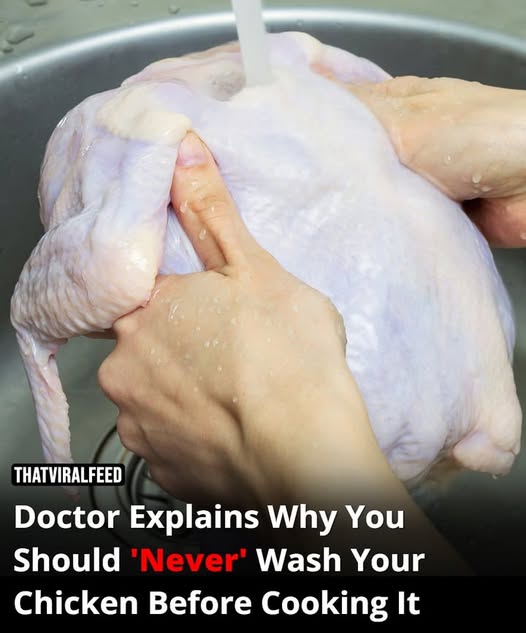It’s something passed down through generations…
“Always wash your chicken before you cook it.”
Your grandmother did it.
Your mother swore by it.
And if you’re like most people, you probably do it too.
It feels like the right thing to do, doesn’t it?
You unwrap that raw, slimy bird and instinctively think: “Let me rinse off all those germs.”
A quick splash under the faucet.
Maybe a bit of lemon.
Or vinegar.
Even saltwater for the more traditional cooks.
It’s supposed to make it cleaner, safer, better.
But what if I told you… it’s actually making things much, much worse?
So much worse that doctors and food safety experts have spent years begging the public to stop — with growing urgency.
This is not a fringe idea.
This is a well-documented food safety emergency that many households have no idea they’re causing.
And I didn’t believe it at first either — until I spoke with Dr. Hannah Leveille, a public health expert and infectious disease consultant who’s seen the ugly aftermath firsthand.
Let me tell you the story that changed my mind forever.
It was a Friday night.
I was prepping for a family BBQ.
Chicken wings, thighs, drumsticks — the works.
As usual, I took them out of the pack, walked over to the sink, and started rinsing them one by one under cold water.
That’s when my friend Claire walked in. She’s a microbiologist who works in clinical research.
She froze mid-step and shouted, “What are you doing!?”
I stared at her, confused. “Washing the chicken. Why?”
What she said next stunned me.
“You’re not cleaning the chicken.
You’re contaminating your entire kitchen.”
At first, I laughed. I thought she was being dramatic.
Then she walked me through what really happens when you wash raw chicken.
Picture this:
The moment water hits that raw chicken, tiny droplets splash everywhere.
Microscopic particles of raw chicken juice — full of salmonella, campylobacter, and E. coli — go flying up to three feet in all directions.
They land on your countertops.
On your cutting boards.
Your sponge.
Your sink faucet.
Maybe even your clean dishes drying beside the sink.
You can’t see it.
You can’t smell it.
But it’s there.
And just one of those droplets can carry enough bacteria to make you seriously ill.
Dr. Leveille told me about a family she treated where everyone got food poisoning — mom, dad, and two young kids.
They thought it was the eggs.
Or maybe the coleslaw.
But it turned out the mother had washed a whole chicken in the sink earlier that day.
And when they swabbed her kitchen afterward?
The highest concentration of bacteria wasn’t on the chicken.
It was on the sink faucet handle — the thing she touched after rinsing the bird.
That one touch spread bacteria to a knife.
Then to a spoon.
Then to the fridge door.
And finally — to the kids’ plates.
One small action led to days of vomiting, fevers, and a hospital stay.
And they had no idea it started with a simple rinse.
So why do we keep doing it?
Because it’s tradition.
Because it feels right.
Because old habits die hard.
But modern science is clear: Washing chicken doesn’t clean it. Cooking does.
No matter how “dirty” the chicken looks — no matter how slimy or smelly — rinsing it under water does not kill bacteria.
In fact, the USDA and CDC have issued official warnings for years:
👉 “Do NOT wash raw poultry.”
👉 “You are increasing your risk of spreading illness.”
Still, about 70% of people admit they wash chicken before cooking.
And many of them don’t even realize the risks.
Some even believe rinsing helps remove blood or “bad smells.”
But here’s the truth:
If your chicken smells that bad, no amount of rinsing will make it safe — it’s probably already spoiled.
The only thing that kills dangerous bacteria on chicken is heat.
Specifically, an internal cooking temperature of 165°F (74°C).
Once your chicken reaches that temperature throughout — not just on the outside — every harmful microorganism is destroyed.
No vinegar.
No lemon juice.
No running water.
Just proper cooking.
“But what if I pat it dry?” some people ask.
That’s okay — as long as you do it carefully.
If you must remove excess moisture, pat the chicken with paper towels and immediately throw them away.
Then wash your hands thoroughly and sanitize the entire area.
And please — never reuse that towel.
This might all sound over-the-top.
It might feel like fear-mongering.
But Dr. Leveille says the data doesn’t lie.
Each year, over 1 million Americans get sick from contaminated poultry.
Thousands are hospitalized.
Some — especially children, the elderly, and immunocompromised — die from foodborne illnesses.
And in many cases, it starts in homes just like yours.
Clean kitchens.
Well-meaning cooks.
Just trying to do the “right thing.”
But when you wash your chicken, you’re not being cautious.
You’re inviting invisible enemies into your kitchen — and onto your plate.
Since that day with Claire, I’ve changed my routine completely.
I unwrap the chicken, place it directly into a clean pan or dish, and throw away the packaging immediately.
I don’t rinse.
I don’t pat.
I just cook it thoroughly.
And guess what?
The chicken still tastes delicious.
Nobody’s gotten sick.
And my kitchen? A whole lot cleaner.
If you take one thing away from this story, let it be this:
Washing chicken before cooking is a dangerous myth.
It feels helpful.
But it’s harmful.
And the best chefs, doctors, and scientists agree.
Don’t rinse.
Just cook.
💬 Have YOU ever washed your chicken before cooking?
Did you know about the risks?
Tag someone who still does this — it might just save them a trip to the ER. 🏥🍗

